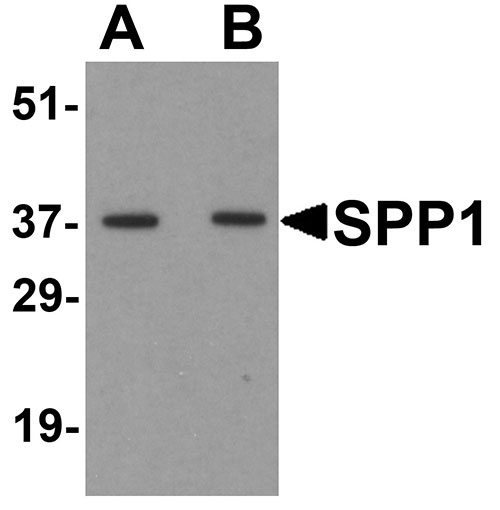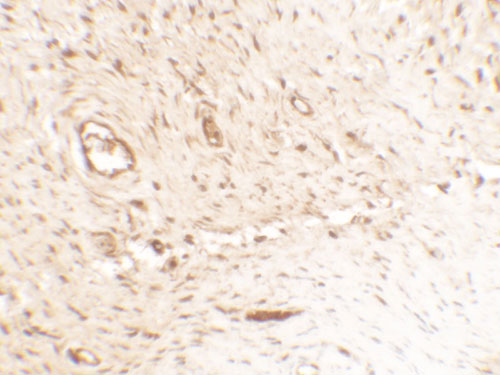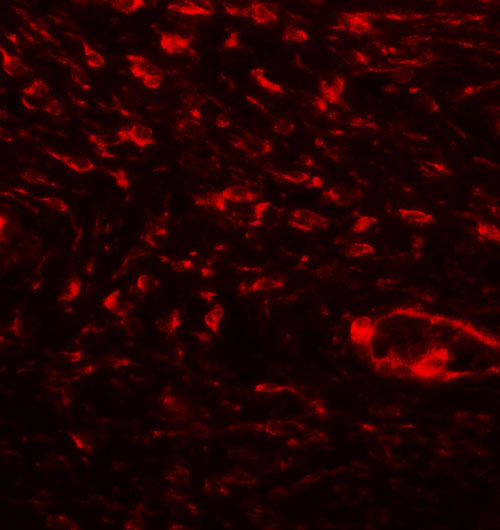SPP1 Antibody
- 产品详情
- 实验流程
- 背景知识
Application
| WB, IF, E, IHC-P |
|---|---|
| Primary Accession | P10451 |
| Other Accession | NP_001238759, 352962176 |
| Reactivity | Human, Mouse, Rat |
| Host | Rabbit |
| Clonality | Polyclonal |
| Isotype | IgG |
| Calculated MW | 35423 Da |
| Concentration (mg/ml) | 1 mg/mL |
| Conjugate | Unconjugated |
| Application Notes | SPP1 antibody can be used for detection of SPP1 by Western blot at 1 - 2 µg/mL. |
| Gene ID | 6696 |
|---|---|
| Other Names | Osteopontin, Bone sialoprotein 1, Nephropontin, Secreted phosphoprotein 1, SPP-1, Urinary stone protein, Uropontin, SPP1, BNSP, OPN |
| Target/Specificity | SPP1; SPP1 antibody is human, mouse and rat reactive. Multiple isoforms of SPP1 are known to exist. |
| Reconstitution & Storage | SPP1 antibody can be stored at 4℃ for three months and -20℃, stable for up to one year. |
| Precautions | SPP1 Antibody is for research use only and not for use in diagnostic or therapeutic procedures. |
| Name | SPP1 |
|---|---|
| Synonyms | BNSP, OPN |
| Function | Major non-collagenous bone protein that binds tightly to hydroxyapatite. Appears to form an integral part of the mineralized matrix. Probably important to cell-matrix interaction. |
| Cellular Location | Secreted |
| Tissue Location | Detected in cerebrospinal fluid and urine (at protein level) (PubMed:25326458, PubMed:36213313, PubMed:37453717) Bone. Found in plasma. |
For Research Use Only. Not For Use In Diagnostic Procedures.
Provided below are standard protocols that you may find useful for product applications.
BACKGROUND
SPP1 Antibody: The secreted protein 1 (SPP1), also known as osteopontin, is a major noncollagenous protein of bone, but is also found in the extracellular matrix of other mineralized tissues and in bodily fluids. In bone, SPP1 is produced by osteoblasts, osteocytes, macrophages, and osteoclasts (1,2). SPP1 binds to cells through integrin and non-integrin receptors, as well as the adhesion receptor CD44 in an RGD-independent manner, enabling SPP1 to induce a number of functional effects including macrophage chemotaxis, cytoprotection, and regulation of T helper type 1 cells (2). SPP1 can regulate biomineralization by inhibiting the formation of hydroxyapatite (3) and the growth of calcium oxalate crystals (4).
REFERENCES
Heinegard D, Andersson G, and Reinholt FP. Roles of osteopontin in bone remodeling. Ann. N.Y. Acad. Sci.1995; 760:213-22.
Wang KX and Denhardt DT. Osteopontin: rule in immune regulation and stress responses. Cyto. Growth Factor Rev. 2008; 19:333-45.
Boskey AL, Maresca M, Ullrich W, et al. Osteopontin-hydroxyapatite interactions in vitro: inhibition of hydroxyapatite formation and growth in a gelatin-gel. Bone Miner. 1993; 22:147-159.
Shiraga H, Min W, VanDusen WJ, et al. Inhibition of calcium oxalate crystal growth in vitro by uropontin: another member of the aspartic acid-rich protein superfamily. Proc. Natl. Acad. Sci. USA 1992; 89:426-30.
终于等到您。ABCEPTA(百远生物)抗体产品。
点击下方“我要评价 ”按钮提交您的反馈信息,您的反馈和评价是我们最宝贵的财富之一,
我们将在1-3个工作日内处理您的反馈信息。
如有疑问,联系:0512-88856768 tech-china@abcepta.com.























 癌症的基本特征包括细胞增殖、血管生成、迁移、凋亡逃避机制和细胞永生等。找到癌症发生过程中这些通路的关键标记物和对应的抗体用于检测至关重要。
癌症的基本特征包括细胞增殖、血管生成、迁移、凋亡逃避机制和细胞永生等。找到癌症发生过程中这些通路的关键标记物和对应的抗体用于检测至关重要。 为您推荐一个泛素化位点预测神器——泛素化分析工具,可以为您的蛋白的泛素化位点作出预测和评分。
为您推荐一个泛素化位点预测神器——泛素化分析工具,可以为您的蛋白的泛素化位点作出预测和评分。 细胞自噬受体图形绘图工具为你的蛋白的细胞受体结合位点作出预测和评分,识别结合到自噬通路中的蛋白是非常重要的,便于让我们理解自噬在正常生理、病理过程中的作用,如发育、细胞分化、神经退化性疾病、压力条件下、感染和癌症。
细胞自噬受体图形绘图工具为你的蛋白的细胞受体结合位点作出预测和评分,识别结合到自噬通路中的蛋白是非常重要的,便于让我们理解自噬在正常生理、病理过程中的作用,如发育、细胞分化、神经退化性疾病、压力条件下、感染和癌症。








